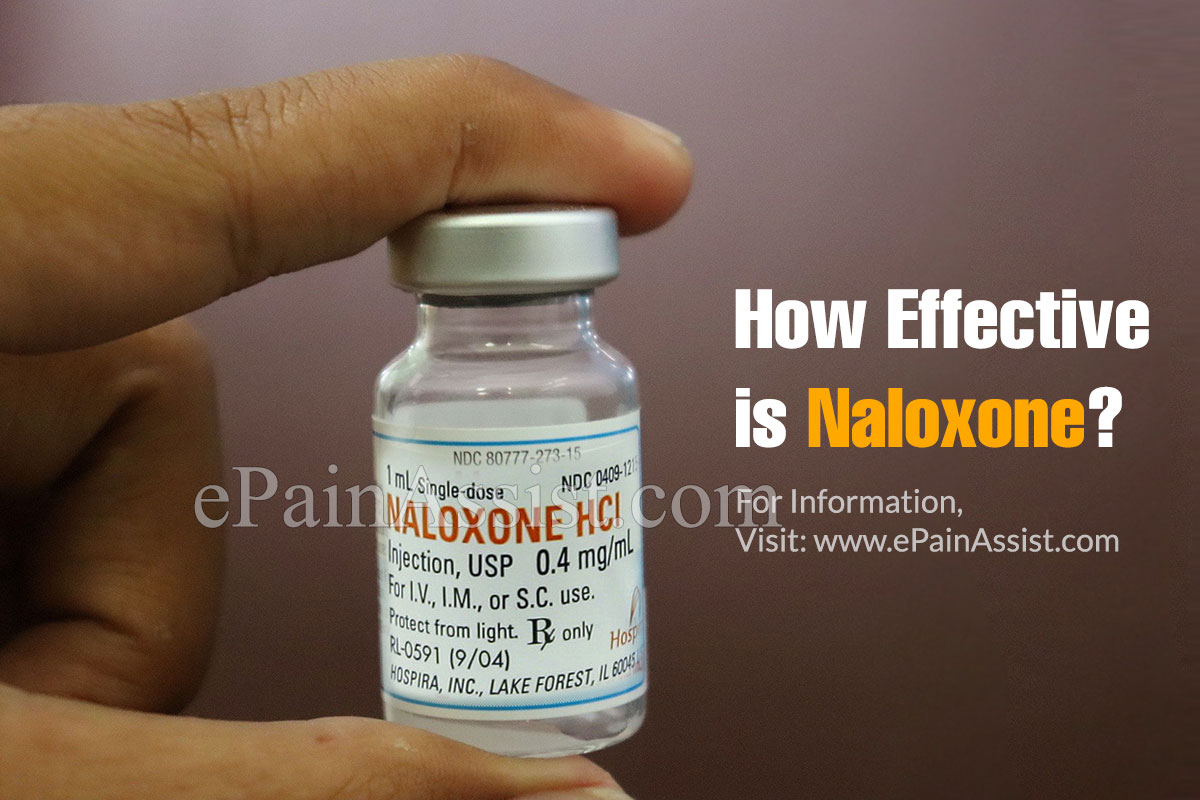The patient should not use alcohol while taking Naloxone due to the potential for serious side effects.
Naloxone can cause impaired thinking and reaction time. Naloxone should not be used while driving a car or undertaking any activity requiring you to be awake and alert.
If you are using prescribed narcotics for pain, the administration of Naloxone will reduce its effect on your pain when it is administered.

How Effective is Naloxone?
Naloxone is used to effectively treat the reactions to opioids (narcotics) including the following:
- Loss of consciousness
- Severe drowsiness
- Slowed respirations
Naloxone is to be used in situations of medical emergency to provide effective treatment for an overdose of narcotics and/or other drugs.
The intent of Naloxone is its use as one component of emergency medical treatment for an overdose.
In addition to treating an overdose, it can effectively help determine whether or not an overdose on narcotics is present.
If a patient experiencing a bad reaction to narcotics, it may not be possible for him/her to tell the first responders about your medication history or other health issues including pregnancy status and whether or not you are breastfeeding. When able, it is important that the patient tell the physician about these issues to determine whether or not further treatment with Naloxone is indicated.
Prior to Taking Naloxone
- Naloxone should not be taken if you are allergic to it or any of its ingredients.
- It is vital you tell your physician about any history of heart disease before being given an injection of Naloxone.
- Its effects on the fetus and breast milk have not been determined, but there are currently no contraindications. However, you must tell your physician if you are planning to become pregnant, are pregnant, or breastfeeding.
- As your emergency condition may prevent complete communication with the medical provider, when able it is important to inform the physician treating your pregnancy about receiving Naloxone.
How is Naloxone Given?
Naloxone is given as an injection into skin, vein, or muscle intravenously. The Naloxone injection may be given by any approved medical provider, first responder, family, friend, or other caregiver with the training needed to give the injection.
It is important that caregivers and family members administering Naloxone read all instructions before giving the injection. The use of a training appliance is recommended prior to needing Naloxone so it is known how to give it in an emergency setting. Any questions or concerns should be directed to the primary care physician or pharmacist.
Recognizing the signs of a narcotic overdose is crucial. Some signs include:
- Shortness of breath
- Slowed respirations
- Slowed heart rate
- Pinpoint pupils
- Severe sleepiness
Even if it is unknown of a narcotic overdose has taken place and the patient is exhibiting any of the above symptoms, Naloxone should be given immediately before emergency medicine arrives to take over care.
Naloxone may be injected into the outer thigh muscle through clothing.
Once Naloxone is injected, the person injecting it should wait and watch for signs of overdose until a first responder is there. It is possible the patient may need other injections every 2 to 3 minutes before medical services arrive. In any case, it is important to follow the dosing instructions provided.
If the Naloxone medication comes with an automatic injection device, it should only be used once then discarded even if there is medication left over in the injection device.
Naloxone should be stored at regular temperature avoiding heat and moisture. Leave the automatic injection device in its case so it is ready for use when needed. If it is noticed that Naloxone has changed color or is mixed with particles, it should be returned to the pharmacy for a new dosage of medication.
What are the Withdrawal Symptoms of Naloxone?
It is important to receive urgent help right away if any of the above allergic reactions are present. Because of the medication’s possible effects on opioid overdosing, Naloxone may cause quick withdrawal symptoms including:
- Nausea
- Runny nose
- Vomiting
- Yawning
- Diarrhea
- Goosebumps
- Stomach pain
- Fever
- Sweating
- Anxiety
- Restlessness
- Body aches
- Shivering
- Irritability
- Weakness
- Fast heart rate
- Increased blood pressure is also a side effect of Naloxone.
In infants less than four weeks old, there may be some withdrawal symptoms such as:
- Seizures
- Overactive reflexes
- Crying
- Stiffness
